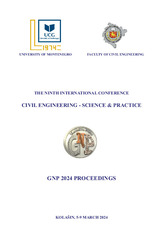Приказ основних података о документу
Comparison of distributed plasticity approaches for inelastic analyisis of reinforced concrete frames
| dc.creator | Tomić, Nikola | |
| dc.creator | Terzić, Anja | |
| dc.creator | Bojović, Dragan | |
| dc.date.accessioned | 2024-03-14T07:53:45Z | |
| dc.date.available | 2024-03-14T07:53:45Z | |
| dc.date.issued | 2024 | |
| dc.identifier.isbn | 978-86-82707-36-3 | |
| dc.identifier.uri | http://rims.institutims.rs/handle/123456789/856 | |
| dc.description.abstract | Following the emergence and establishment of performance-based design as a widely recognized and applied practice, numerous significant advances in computational techniques have been made. Arguably, nonlinear methods of analysis – static or dynamic – provide the most detailed and accurate insight into behavior of the structure which is designed or assessed. While the current codes of practice permit their use, provisions are vague in some aspects, leaving many decisions and assumptions up to the engineer. This paper aims to expand the relatively limited experience with implementation of different distributed plasticity modeling approaches through a case study based on experimental data. Some particulars of the behavior of structural elements made of strain-softening materials, and of their corresponding numerical models, are briefly introduced. Case study is conducted to provide an overview on the procedures for inelastic analysis of reinforced concrete frames through a side-by-side comparison of four alternative approaches for modeling of RC beams and columns with one-dimensional distributed plasticity finite elements with fiber-discretized cross sections. The analyzed structure consists of a reinforced concrete column with a fixed base, which is, under varying axial loads, subjected to monotonic and cyclic lateral displacements applied at its top. Models comprised of force-based elements with different arrangements of integration points, as well as of displacement-based elements, are compared. Advantages, limitations and special considerations which need to be taken into account for each of the approaches are demonstrated through the example. Influence of concrete confinement is studied by analyzing another column with a different arrangement of transverse reinforcement. Global structural response is evaluated by comparison of pushover and cyclic curves for different models. Influence of modeling approach on objectivity of the local response and the corrections which need to be made for certain approaches are showcased by moment-rotation curves of the yielded section at the column base. Considerations and findings presented in the paper, along with other published case studies, can be used for reference when preparing a computational model for inelastic analysis of a reinforced concrete structure. | sr |
| dc.language.iso | en | sr |
| dc.publisher | University of Montenegro Faculty of Civil Engineering | sr |
| dc.relation | info:eu-repo/grantAgreement/MESTD/inst-2020/200012/RS// | sr |
| dc.rights | openAccess | sr |
| dc.rights.uri | https://creativecommons.org/licenses/by-sa/4.0/ | |
| dc.source | The ninth international conference civil engineering science & practice, GNP 2024 proceedings, Kolašin, Montenegro | sr |
| dc.subject | Nonlinear analysis | sr |
| dc.subject | performance-based design | sr |
| dc.subject | seismic assessment | sr |
| dc.subject | finite elements | sr |
| dc.title | Comparison of distributed plasticity approaches for inelastic analyisis of reinforced concrete frames | sr |
| dc.type | conferenceObject | sr |
| dc.rights.license | BY-SA | sr |
| dc.citation.epage | 304 | |
| dc.citation.spage | 297 | |
| dc.identifier.fulltext | http://rims.institutims.rs/bitstream/id/1919/bitstream_1919.pdf | |
| dc.identifier.rcub | https://hdl.handle.net/21.15107/rcub_rims_856 | |
| dc.type.version | publishedVersion | sr |

